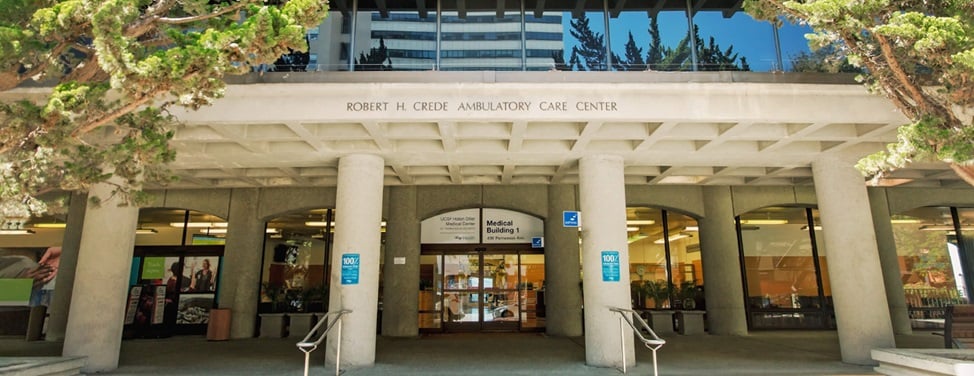
Bariatric Surgery
Obesity is a chronic disorder that can lead to other health problems, including diabetes, high blood pressure and obstructive sleep apnea. Because obesity can affect many organs, it may be difficult to treat. When other medically supervised methods have failed, weight-loss surgery can offer an effective way to lose weight and keep it off.
To be considered for weight-loss surgery, you must have one of the following:
- A body mass index (BMI) of 40 or higher
- A body mass index (BMI) between 35 and 40 plus an obesity-related condition, such as heart disease, diabetes, high blood pressure or severe sleep apnea
BMI is calculated by dividing your weight in kilograms by your height in meters squared. A BMI of 20 to 25 is considered normal. See our BMI chart.
The UCSF Bariatric Surgery Center has been performing surgical weight-loss procedures since 1996. The main procedures we offer are gastric bypass and sleeve gastrectomy, both performed using minimally invasive techniques. These surgeries are considered "restrictive," meaning they limit the amount of food you can eat at one time. We also offer lap-band removal and bariatric revision surgery, which are procedures to address problems some patients experience from past weight-loss surgery.
During your initial visit, one of our bariatric surgeons will describe the operations in detail, explain the risks and benefits of each, and determine which procedure is best for you.
When considering weight-loss surgery, you should understand that success in maintaining weight loss depends on your commitment to making major diet and lifestyle changes. Surgery is a powerful tool meant to assist weight loss. Participation in your treatment plan at home and through our bariatric program is essential to achieving your weight loss goals and to maintaining the loss for years after surgery.
Weight-loss procedures at UCSF
Gastric bypass
Gastric bypass is the current gold standard for weight-loss surgery, according to the American Society for Metabolic and Bariatric Surgery and the National Institutes of Health. This procedure causes ingested food to bypass most of the stomach and the first part of the small intestine.
In the procedure's first step, a small stomach pouch is created using a surgical stapler. The remainder of the stomach isn't removed but is stapled shut. The pouch restricts food intake and allows a feeling of fullness from fewer calories. Next, the small intestine is divided, and one end is raised and attached to the stomach pouch in a procedure called a gastrojejunostomy. The other end of the small intestine, still connected to the stomach remnant, is reconnected to another portion of the intestinal tract in a procedure called a jejunojejunostomy. Rerouting the intestinal tract causes the small intestine to absorb fewer calories during digestion. It also leads to changes in gut hormones, and these changes suppress hunger and promote a full sensation.
Advantages of gastric bypass include:
- Average weight loss is 60 to 80% of excess body weight.
- Average weight loss is greater than the average achieved by two other weight-loss procedures, sleeve gastrectomy and gastric band surgery.
- Studies show gastric bypass surgery alters the metabolism of carbohydrates and increases insulin sensitivity, often eliminating the need for diabetes medications.
- Medical conditions related to obesity – such as acid reflux, high cholesterol, high blood pressure and sleep apnea – improve or even go away after surgery.
Disadvantages of gastric bypass include:
- Vitamin B12, iron, calcium and folate are less well absorbed because the duodenum (the first part of the small intestine) is bypassed. To prevent anemia, bone disease and other problems associated with nutrient deficiencies, patients must take daily multivitamins.
- A condition known as "dumping syndrome" can occur after eating too quickly or after eating foods high in refined sugars, carbohydrates or fat. Symptoms include nausea, sweating, light-headedness, flushing and a fast heart rate.
- The bypassed portions of the stomach and small intestine can't be easily visualized using X-ray or endoscopy. This can be a problem if patients develop ulcers, bleeding or cancer in these areas.
- While complication rates are low, complications are about twice as common in gastric bypass surgery as in sleeve gastrectomy, which is less complex.
Sleeve gastrectomy
This operation, often called "the sleeve," involves only the stomach. A small sleeve, or narrow pouch, is created using a surgical stapler. After the sleeve is created, the rest of the stomach – about two-thirds of the stomach – is removed. The sleeve leads quickly to a full feeling and decreases appetite. Only small amounts of food can pass through the sleeve at one time. This procedure also triggers gut hormone changes that can reduce hunger, increase feelings of fullness and better control blood sugar.
Advantages of sleeve gastrectomy include:
- No foreign body is implanted.
- There is no rerouting of the intestinal tract.
- Average weight loss is greater than with gastric band but may be slightly less than with gastric bypass.
Disadvantages of sleeve gastrectomy include:
- The procedure is not reversible.
- We have less long-term data on the outcomes of sleeve gastrectomy.
- There is a risk of leaking at the staple line of the stomach.
- About 30% of patients have new or worse heartburn after surgery. While most cases can be addressed with medication, some patients with severe symptoms may require an additional surgery.
Lap-band removal
A lap band, also called an adjustable gastric band, is an inflatable band placed around the stomach to limit how much food can be eaten at one time. Patients may experience complications following lap-band insertion, including band slippage, which can cause pain and nausea, or band erosion, which damages stomach tissue.
Because of the high complication rate, the UCSF Bariatric Surgery Center does not offer lap-band insertion. We do perform lap-band removal for patients experiencing band slippage and band erosion, as well intolerance, infection or other complications. Lap-band removal involves cutting and extracting the band and any surrounding scar tissue, as well as removing the access port used to inflate the band.
Advantages of lap-band removal include:
- It reverses most complications and eliminates side effects caused by the gastric band.
- The risk of additional complications associated with the removal surgery is low.
- Patients may have the option to undergo a different weight-loss procedure, which can be performed simultaneously in some cases.
Disadvantages of lap-band removal include:
- Patients may gain weight once food intake is no longer physically restricted.
- Cases where the lap band damaged stomach tissue may require several months of recovery before another weight-loss procedure can be performed.
Bariatric revision surgery
Gastric bypass and sleeve gastrectomy procedures have high success rates, but in some cases, a second surgery is needed. Some patients experience undesirable side effects, such as severe heartburn or trouble swallowing. Others face medical complications, including a stretched stomach pouch, an ulcer that doesn't heal or problems with the surgical staples. Revision surgery may involve decreasing the size of the pouch, re-creating the gastric sleeve, or converting a sleeve to a gastric bypass.
We can usually perform these revisions using minimally invasive techniques, bringing relief from discomfort or complications caused by an earlier surgery. However, some revisions are more complex than an initial procedure and may therefore carry a higher risk of infection or additional complications.
For patients who have experienced inadequate weight loss or weight regain after bariatric surgery, we recommend following a medically supervised weight-loss program for six months before considering a second surgery.
Minimally invasive surgery
At the UCSF Bariatric Surgery Center, we use laparoscopic surgery, a minimally invasive approach, for more than 90% of procedures. Traditional "open" bariatric surgery requires the surgeon to make one long incision into the abdomen. In laparoscopic surgery, the surgeon instead inserts a tiny camera and slender surgical instruments though several small incisions.
In some cases, our surgeons use a robotic-assisted laparoscopic approach, which can increase precision and control in highly complex or delicate procedures. Learn more about the UCSF Robotic Surgery Program.
The American Society for Metabolic and Bariatric Surgery recommends that laparoscopic weight-loss surgery be performed only by surgeons experienced in both laparoscopic and open bariatric procedures. At the UCSF Bariatric Surgery Center, our experts are trained in both traditional bariatric techniques and the advanced techniques of laparoscopy.
Studies show that laparoscopic weight-loss procedures have several benefits for patients when compared to open surgery, including:
- Less pain after surgery
- Fewer wound complications, such as infection or hernia
- Faster recovery and return to normal activities
Endoscopic procedures
We use another minimally invasive approach, known as upper endoscopy, to address certain bariatric surgical complications and perform revisional procedures. In an upper endoscopy, we pass a small camera attached to a long, flexible tube into the throat. This allows us to examine the stomach without creating an incision. Medications and medical devices can also be inserted into the intestinal tract using this method. Learn more about endoscopic weight-loss options.
UCSF Health medical specialists have reviewed this information. It is for educational purposes only and is not intended to replace the advice of your doctor or other health care provider. We encourage you to discuss any questions or concerns you may have with your provider.




















